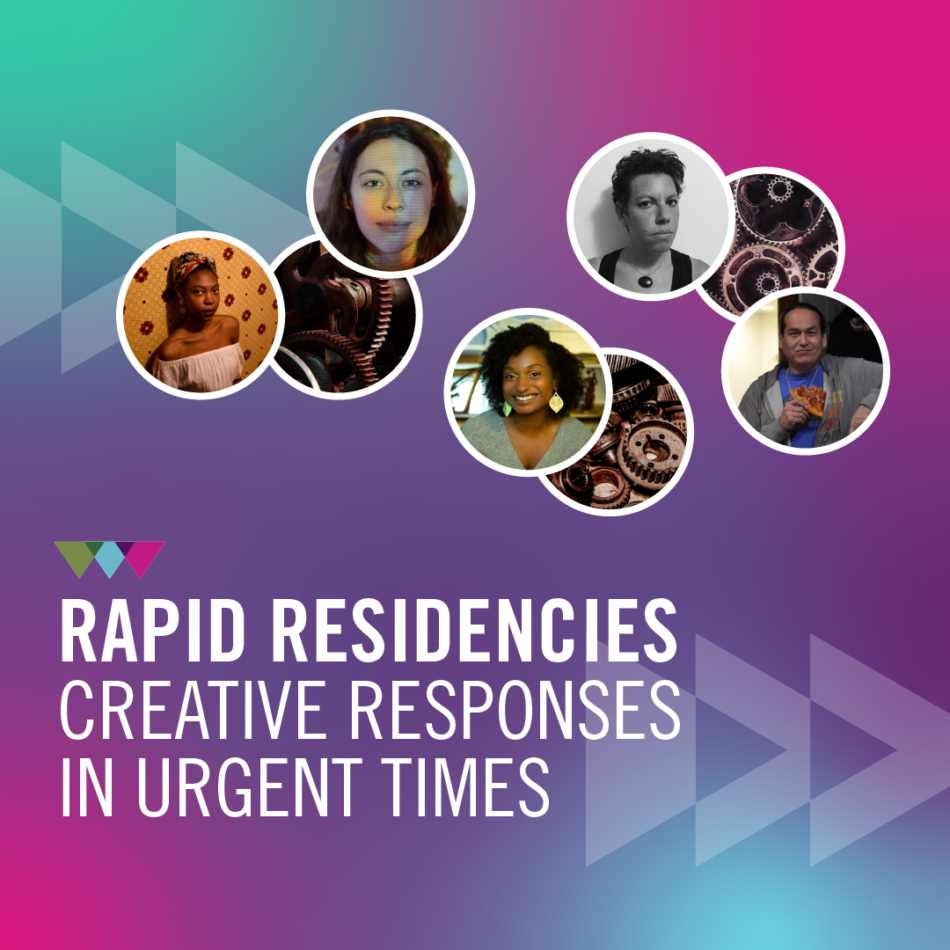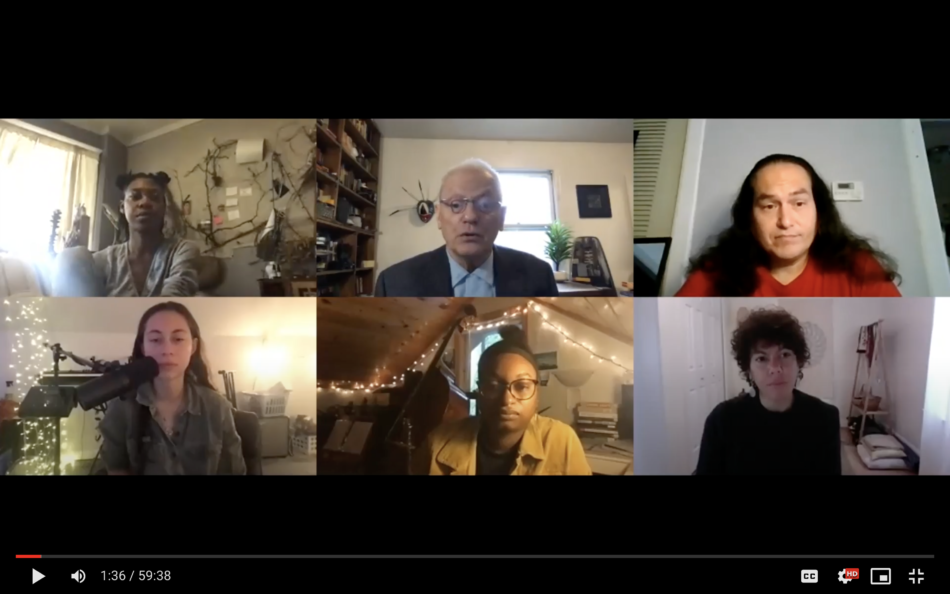The onset of the COVID-19 pandemic brought forth global change and disruptions that impacted all aspects of life. As part of efforts to “flatten the curve,” shelter-in-place orders became prevalent and widespread shutdowns of businesses and educational institutions attempted to thwart community transmission of the virus. These measures profoundly impacted cultural institutions, producers, and creators. Opportunities dwindled worldwide as gigs were lost, performances and exhibitions closed, and myriad other events moved online or were canceled. Moreover, while institutions struggled with lost revenues that impacted operations, artists and creatives experienced a critical loss of income to support their livelihoods. To spark innovation and creativity during those challenging times, MSU Museum’s CoLab Studio (previously, Science Gallery Detroit1) launched a new, virtual residency program for creatives. The goal for the initiative, dubbed a Rapid Residency program, was to foster conceptual ideas that responded to the COVID-19 pandemic.
Inspired by a similar program initiated by friends and colleagues at Science Gallery Dublin2, this effort provided a $1,000 financial stipend and mentoring to a select group of creatives. Specifically, the Detroit-based program intended to spark innovative responses to current social challenges impacting Detroiters.
The virtual, five-week program began with an open call to creatives residing within the city. To garner interest, the CoLab Studio team carefully crafted the open call to ensure a broad range of ideas and investigations, including those with uncertain outcomes or that were novel and/or experimental. This included potential installations, performances, social practices, experiments, written and spoken word pieces, sound, movement, video work, general research, online works, and more. Furthermore, given the short duration on the residency program, recipients were not expected to create a finalized work, exhibition, or demonstration. Alternatively, awardees were encouraged to create conceptual ideas that could lead to the creation of a product at a later date. The only mandatory expectation of awardees was participation in a culminating virtual public event, which included a moderated dialogue with a virtual public.
Much of CoLab Studio’s work designing exhibitions and public programs leverages an open call process. Therefore, the approach to initiating the Rapid Residency project built on many lessons learned from previous work. For this effort, the Studio’s team wanted to ensure the greatest amount of accessibility by minimizing the work required to submit a proposal. The application simply requested that prospective candidates provide a brief overview of their concept or idea, explaining why this residency would be valuable and what impact the applicants hoped it could have on their work. Proposals were limited to 200 words or less.
In sum, approximately 60 people applied for five residencies. The volume of submissions exceeded expectations, which reinforced the urgent need for artistic work and income. Furthermore, the quality of the proposals, which came from both emerging and established creatives, were thoughtful and inspiring. The five selected creatives, along with a short description of the projects they planned to develop, included:
- Cherise Morris: a set of concepts related to quantum physics, poetic texts, slave songs, and African spirituality
- Jordyn Davis: concepts related to the creation of antiracist musical compositions, drawing on diverse musical traditions
- Summer Krinsky: concepts related to using sound to reflect on interrelated systems, both those connected to the response to COVID-19 and those seemingly only distantly related systems, using data scraping and scientific visualization tools
- Amira Hanafi: concepts related to creating community around asylum artists in a residency program, and embedding that in the activities of community centers and language justice practices
- Maiingen “iNDio” Wekwidong: concepts related to creating physical historical art markers and installations that articulate the spaces in Detroit that related to Annishnabeg presences before the colonial onslaught, eventually using virtual reality (VR) and augmented reality (AR) visualizations of those sites to provide contextual information, augmented by onsite QR codes, that recall the history and memory of those places.

What We Learned
“Participating in the Rapid Residency was overall a very positive experience for me as an artist. My application for this residency was for a project that was halted as a direct result of COVID-19. The resources and guidance provided to me in support of this project ultimately helped revitalize the musical work while also creating space for me to reconceptualize my vision for the piece and its premiere as a whole.” — Jordyn Davis3
Given the novel nature of this initiative and the rapid launch of the project during urgent times, our team learned a great deal while implementing this work. Some important lessons gleaned from this effort include:
- Virtual residencies provide both unique challenges and opportunities. The virtual format prohibits one from immersing themselves in a particular environment that could influence and inform the development of work. However, the virtual format also provides a greater level of flexibility. For example, the format enables more accessibility by decreasing the barriers for connecting people across time and space. Furthermore, there are inherent savings on operational and programmatic costs.
- The five-week duration of the residencies enabled an appropriate amount of time for the generation of creative ideas and concepts. Providing mentors to help advance ideas added to efficiencies.
- The cultivation and pairing of mentors with artists required careful consideration. To provide the most value, developing a robust pool of potential mentors in advance of initiating the project is key. Creating a “menu” of mentors with diverse expertise and specializations can maximize the experience for artists.
- Originally, the idea to focus on generative ideas instead of an actual culminating project was based on the limited duration of the residency and the context of the environment. Based on conversations with the awardees, this was perhaps the most valuable aspect of the residency. It’s rare to find spaces that support the generation of ideas without expectations of finalizing work.
- At the conclusion of the initiative, the awardees felt there would be much value in introducing the creatives to each other at the onset of the project. This would help them feel more connected and able to support each other through the development of their respective works. This was a valuable insight given we had not considered the idea of building a supportive cohort in this initial pilot project. The focus was placed on connecting artist with mentor, but not artist to artist.
- With respect to cohort building, we were pleased to discover that at least two creatives collaborated to produce a new work at the conclusion of the project. This reinforces the idea of connecting artists and the need for facilitating the group as a cohort.
Future Applications
The Rapid Residency initiative was deemed both a success and a program that MSU Museum would build from as we look to the future. We foresee a number of ways in which a similar approach may impact programs. This includes piloting efforts to activate the Museum’s collections, designing interdisciplinary efforts to foster new collaborations, and piloting new initiatives through rapid prototyping. Ultimately, the Rapid Residency program is a generative initiative for launching new possibilities.

Notes
1 In 2017, Michigan State University partnered with Science Gallery International to launch Science Gallery Detroit, which became the first member of the esteemed Science Gallery Network in the Americas. However, in July 2021, Science Gallery Detroit became a programmatic division of the Michigan State University Museum aimed at experimentation and innovation. This pivot came following many new developments at Michigan State University, including a new strategic plan — MSU 2030 — which established new priorities for the University. In light of this, the purpose of MSU’s Science Gallery changed from its initial conceptualization. As of fall 2022, MSU’s Science Gallery became the MSU Museum CoLab Studio. The Studio’s timely and relevant programs are novel, transient, and experimental. This approach enables our team to explore new methods for designing and implementing programming, informal learning, and community engagement. Findings from our work enables the MSU Museum to capitalize on new ways to engage students, faculty, and researchers as it works to maximize its mission. To this end, the CoLab Studio helps to push the boundaries of what it means to be a 21st century interdisciplinary museum.
2 Balaniuk, Jahitza. “The Rapid Residencies: An Initiative to Support the Local Creative Community.” The Science Gallery Network, 23 June 2022, https://sciencegallery.org/stories/the-rapid-residencies-an-initiative-to-support-the-local-creative-community.
3 The world premiere of a new original composition by Jordyn Davis, “Stand Up (for Breonna Taylor),” was commissioned in part by Science Gallery Detroit’s Rapid Residency for Tuba, Electric Bass, String Quartet, Drumset, & Spoken Word. This piece was written to empower Black people to get out into the world & use their voices in honor of the life of Breonna Taylor & the many innocent Black lives lost as a result of police brutality. To view the work, please visit https://youtu.be/xzoOVcjUCFQ.